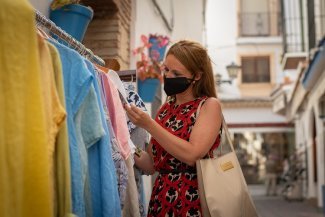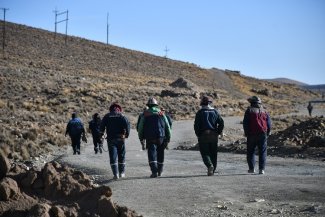A worker in front of her sewing machine at the Nana Atelier factory in Boyle Heights, Los Angeles, 14 June 2021.
Maria, 58, rapidly sews one piece after another, deftly operating her sewing machine with the kind of skill that comes from her many years of experience as a seamstress. But at just three cents for each label sewed and five cents for adding a trim to a piece of clothing, she never manages to make more than US$6 an hour. Maria, who is undocumented, has been working for 30 years in the fashion district of Los Angeles, the capital of the United States’ garment industry, which employs more than 40,000 people, the vast majority of them immigrants. “As long as I’ve done this job I’ve always been paid by the piece rather than by the hour. And the pay has never gone up,” she says.
In order to earn around US$250 a week, Maria has to work up to 12 hours a day Monday to Friday, from 7am to 1pm on Saturdays and sometimes even on Sundays. The working conditions she faces aren’t too dissimilar to those found in some sweatshops in Asia: despite the high temperatures that prevail most of the year in Los Angeles, most factories are neither air-conditioned nor ventilated. “Many workers even avoid drinking so they don’t waste time going to the toilet. My colleagues often develop kidney problems because of this,” she says.
A few months ago, Maria joined a female-led coalition fighting for passage of the Garment Worker Protection Act (also known as Senate Bill 62), a bill currently being debated in the California State Legislature that would put an end to exploitative practices in the garment industry.
“SB62 targets the problem of wage theft, which is particularly prevalent in the fashion industry,” explains California State Senator Elena Maria Durazo, who authored the bill. “The garment industry in California owes more than US$7 million in unpaid wages,” says Durazo, who understands the problem well. The daughter of Mexican immigrants, in the 1980s Durazo worked as a union organiser for the International Ladies’ Garment Workers’ Union, one of the largest garment workers’ unions in the United States. “Despite the passage of several pieces of legislation over the last few decades aimed at ending the problem of unpaid wages, not much has changed. Factories still manage to take advantage of loopholes in the system to continue their practices,” she says.
Abolishing the piece-rate wage system
“The biggest problem with the piece-rate wage system is that it is one of the main drivers of wage theft,” says Marissa Nuncio, director of the Garment Workers Centre, an organisation that advocates for the rights of garment workers in Los Angeles. “Prices have been stagnant for decades and can be as low as 2 cents a piece even though the minimum wage has increased in California. Continuing to pay workers in this way prevents them from meeting the minimum wage. At the rates charged, they would have to sew an incalculable number of pieces in an hour that no human is capable of.”
The piece-rate wage system also forces workers to move at a gruelling pace that is often detrimental to their health. “When your salary depends on how fast you work, you are much more likely to have an accident,” says Nuncio. “You can cut yourself, puncture your hand...the needle of the sewing machine can break and land in your eye. Garment workers also very often have muscle problems because of the repetitive nature of the tasks they perform.”
According to the Garment Workers Centre, garment workers in Los Angeles earn an average of US$5.50 an hour while the city’s minimum wage now stands at US$15 an hour as of 1 January 2020.
Significant anti-sweatshop legislation previously passed in California in 1999. Assembly Bill 633 was intended to ensure that garment workers are paid the minimum wage and compensated for overtime while holding manufacturers and retailers accountable for violations. But fashion companies have found it very easy to circumvent the law by using multiple layers of subcontracting that allow them to offload their responsibilities. “Because these companies use subcontractors to manufacture the clothes, they can claim that they are not ‘manufacturers’ themselves and that AB 633 thus does not apply to them,” says Durazo.
SB62, on the other hand, targets the root problems of the garment industry: “This bill aims to tighten the chain of responsibility by holding brands accountable for the clothes they produce. The bill would also ban the piece-rate system as the main means of payment. Instead, once the minimum wage is reached, a piece-rate bonus incentive system can be applied,” she explains.
Working conditions similar to sweatshops in Asia
Among those campaigning for the law’s passage are a large number of women. “It makes sense because about 60 per cent of the industry is female,” says Nuncio. “Women very often take leadership roles in workers’ rights campaigns because they are the ones who face the most difficulties in the garment industry,” she explains. “There is often a wage gap between men and women, even for low-paid work. Because of their physical build, men are often assigned the most difficult tasks for which they are paid slightly more,” says Nuncio. “Women also face sexual harassment in factories and often have no way to defend themselves.”
In addition to the seamstresses and politicians fighting for SB62, several female owners of ethical clothing factories in Los Angeles have joined the campaign. One of them is fashion designer Alnea Farahbella, co-founder of Nana Atelier, a small garment factory in the Boyle Heights neighbourhood of Los Angeles.
“I lived in Asia for 10 years before moving to California,” she says. “When I arrived in Los Angeles five years ago, I was horrified by the working conditions in the fashion district, which are not too dissimilar to those found in Asia. People here are sometimes paid US$3 an hour, which is similar to the salary a Chinese worker makes, except they live in Los Angeles where the cost of living is very high,” she says.
“That’s why I support the campaign for SB62. Of course it’s not going to revolutionise the system, but it’s a good start. It will at least force brands to work with companies that respect the law. Today 90 per cent of factories pay workers by the piece.”
Together with her partner Arno Nabos, Farahbella employs around 15 garment workers who make pieces for both her own brand Toit Volant, as well as for others. But the working conditions at their factory are very different to those typically found in the garment factories of Los Angeles.
Instead of being crammed together, the workers they employ work in a bright and ventilated 450 square metre space. “All of our workers have employee status, whereas most factories hire self-employed workers on a piece-rate basis so they don’t have to pay taxes or meet minimum wage requirements. We didn’t want to participate in that system,” says Farahbella. Nana Atelier’s employees are also able to work at a slower pace than California’s sweatshop workers: “No one is looking over their shoulders asking them to speed up. We focus on quality rather than quantity. Our employees work from 7am to 4pm with breaks in between,” says Nabos.
Threats of relocation
Of course, this more ethical approach comes at a cost: “There is a difference of 7 to 10 dollars per item between what we produce and what other factories produce that don’t respect all these rules,” explains Farahbella. “But that’s also to be expected since we respect the minimum wage. The problem is that consumers have gotten used to paying very little because of these factories that don’t respect the law. There’s a lack of education on these issues.”
California legislators have until 10 September to vote on SB62. Many clothing companies who oppose the bill will do everything in their power to dissuade elected officials from passing it. Many argue that SB62 would increase labour costs in Los Angeles and force retailers to move manufacturing overseas.
“Every time we try to improve conditions for workers we always hear the same dire warnings. But the shortages we experienced during the health crisis, especially when it came to masks, made us realise that we needed skilled local workers to be able to respond quickly to demand rather than having to depend on foreign manufacturing, which comes with additional delivery costs and often takes longer to arrive at its destination,” says Senator Elena Maria Durazo. “The reality is that the pandemic is slowly changing attitudes in the textile industry.”













